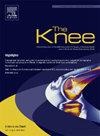使用统计参数映射法研究亚洲膝关节骨关节炎患者在站立和行走时的生物力学差异:横断面研究
IF 2
4区 医学
Q3 ORTHOPEDICS
引用次数: 0
摘要
背景:利用运动捕捉系统对膝关节骨性关节炎(KOA)患者的生物力学进行了广泛的研究,但对站立膝关节角度与行走参数,尤其是亚洲人的站立膝关节角度的研究较少。我们的目的是利用一维统计参数映射(SPM1D)确定亚洲人群中健康和 KOA 参与者的步态生物力学差异,并探讨这些差异是否与站立关节角度有关:共有 20 名 KOA 和 24 名健康人直立行走 10 米,速度自定。分析了站立角度、踝关节、膝关节、髋关节和躯干的行走运动学和动力学参数。通过肌电图测量了下肢肌肉的兴奋性。使用 SPM1D 对健康组和 KOA 组进行比较,并进一步进行分组分析:结果:所有 KOA 组的站立膝关节屈曲角 (KFA) 明显更大(P 2 = 0.579),KOA 组的平均行走膝关节屈曲角 (R2 = 0.801)也明显更大:结论:在 KOA 组中,站立膝关节屈曲角的增加与步行膝关节屈曲角的增加相关。静态关节角度仍然是一个重要参数,但还需要进行进一步研究,以确定在使用运动捕捉对 KOA 进行步态分析时,是否可以建议将站立关节角度的增加作为一项辅助测量指标。本文章由计算机程序翻译,如有差异,请以英文原文为准。
Biomechanical differences of Asian knee osteoarthritis patients during standing and walking using statistical parametric mapping: A cross-sectional study
Background
Biomechanics of knee osteoarthritis (KOA) patients have been extensively studied using motion capture systems, but less have explored standing knee joint angles with the walking parameters, particularly in Asians. We aim to determine gait biomechanical differences between healthy and KOA participants in an Asian population using One-dimensional Statistical Parametric Mapping (SPM1D) and explore if they are associated with standing joint angles.
Methods
A total of 20 KOA and 24 healthy stood upright and walked 10 m at self-selected speeds. The standing angles, walking kinematic and kinetic parameters of the ankle, knee, hip and trunk were analysed. Lower limb muscle excitation was measured via electromyography. SPM1D was used to compare the healthy group with the KOA group, and for further subgroup analysis.
Results
The all KOA group had significantly greater standing knee flexion angles (KFA) (p < 0.001), standing ankle dorsiflexion angles (ADA) (p < 0.001), walking KFA during terminal stance (p = 0.001) and terminal swing (p = 0.02) and walking ADA during terminal stance (p = 0.02) and mid-swing to terminal swing (p = 0.001). Knee adduction moment (p = 0.04) and knee flexion moment (p = 0.03) were higher in severe KOA. A positive correlation was found between standing KFA and initial KFA (R2 = 0.579), and mean walking KFA (R2 = 0.801) in the KOA group.
Conclusion
The increase in standing KFA was associated with an increase in walking KFA in the KOA group. Static joint angles remain as an essential parameter, although further studies need to be carried out to determine if the increase in standing joint angles can be recommended as an adjunctive measure during gait analysis of KOA using motion capture.
求助全文
通过发布文献求助,成功后即可免费获取论文全文。
去求助
来源期刊

Knee
医学-外科
CiteScore
3.80
自引率
5.30%
发文量
171
审稿时长
6 months
期刊介绍:
The Knee is an international journal publishing studies on the clinical treatment and fundamental biomechanical characteristics of this joint. The aim of the journal is to provide a vehicle relevant to surgeons, biomedical engineers, imaging specialists, materials scientists, rehabilitation personnel and all those with an interest in the knee.
The topics covered include, but are not limited to:
• Anatomy, physiology, morphology and biochemistry;
• Biomechanical studies;
• Advances in the development of prosthetic, orthotic and augmentation devices;
• Imaging and diagnostic techniques;
• Pathology;
• Trauma;
• Surgery;
• Rehabilitation.
 求助内容:
求助内容: 应助结果提醒方式:
应助结果提醒方式:


